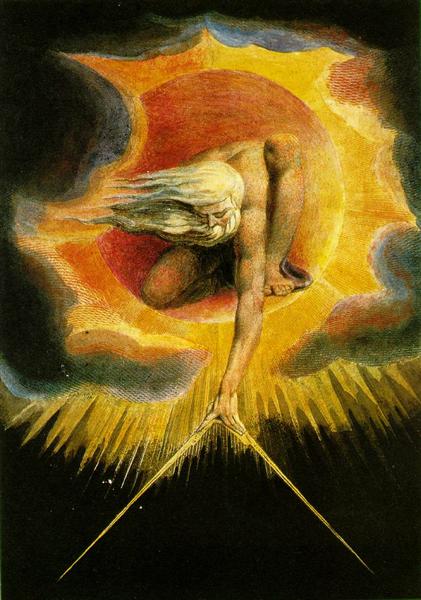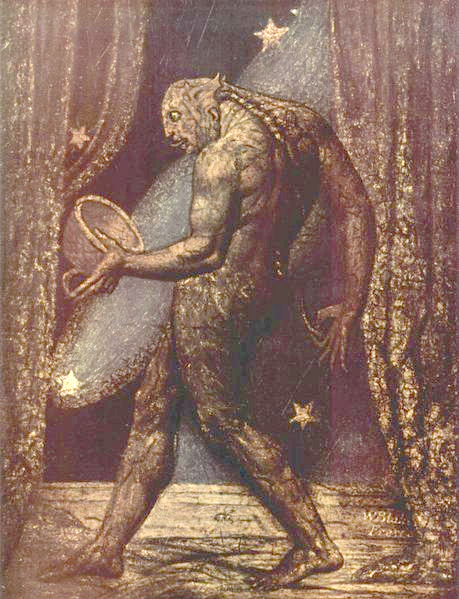Art Life and Lives-William Blake (Patreon)
Content
William Blake is primarily known as a poet but he was equally a visual artist working in engraving and painting. He was born in 1757 and died in 1827.
I would describe William Blake as a multi disciplinary visionary artist from the early Industrial Revolution before the term visionary artist existed.
Alex Grey, who is a contemporary icon of visionary art defines visionary art as
"Art that purports to transcend the physical world and portray a wider vision of awareness including spiritual or mystical themes, or is based in such experiences."
And this is almost a perfect description of Blake's work.
One interesting thing to do if you’re unfamiliar with William Blake is to just google 18th century English art and look at the paintings that were popular around that time.
Most of it looks like this.

Then type in William Blake art. And You'll see stuff like this.

His art was based mostly on these esoteric and sort of cryptic visions that he had through out his life.
Even though he would almost surely find an audience and be celebrated today, where there is an established tradition and an appetite for personal vision and unique interpretations of spiritual and psychological experiences, he was mostly ignored his whole life. Many people dismissed him as crazy, and he died penniless in a pauper's grave.
This lawyer named Henry Crabb Robinson wrote about his interactions with Blake at a dinner party in his diary. He Wondered “Shall I call him artist or genius or mystic or madman?”
And Blake was a little from every category. He got into a heated argument with a thistle, he talked casually about visions, he had distain for religion but was deeply religious, he had radical political views but rejected the ideology of political radicals.
Out of these contradictions and visions he developed a complex mythology
"Envisioning Albion, a sleeping giant divided into warring psychic components, the Four Zoas, and as such predicts modern psychological models of the fractured or unbalanced psyche. But his vision is ultimately a hopeful one, a cosmic narrative which culminates in humanity’s return to unfallen, eternal existence, and which stresses the centrality of Human Imagination as, literally, Divine." -From the Blake Society
Though his mythology has been difficult for me to grasp, there are a lot of ideas and archetypal figures in it that I think are very useful. For example this character Urizen. A stern, oppressive figure who represents blind reason and limitation. Creating a superficial world in his own image and insisting that it's the only truth.
I've read a lot of psychological literature on the nature of how we form beliefs, cognitive biases, moral foundations theory, and the left/ right hemisphere divide. and I think that the character of Urizen is a good archetypal figure to get at all of this.
In concrete terms, when you're at that family dinner and your uncle starts going off about his political, religious views or whatever. Going into that us vs. them mode. Insisting that he and those like him are the ones with the right views. And that their views will fix all the problems, if only all those stubborn morons who disagree would get out of the way: that's Urizen.

"The Ancient of days" A painting of Urizen by Blake.

"Newton" by Blake. Depicting Isaac Newton as Urizen.
But the primary value of Blake to me is this "divine imagination," as the Blake society put it. That is the most attractive thing to me about Blake as an artist.
Blake saw his visions as coming from within him. He viewed all religious experience that way. He viewed religions as human creations rather than supernaturally revealed truths (as many religions ask us to believe about them.)
Heaven and hell aren’t real places that we end up after we die. They are symbolic reflections of our experience here and now. And to Blake, paradise and heaven are the creative state of making art. Imagination is God.
As I said, Blake died penniless and was given a paupers burial. But he died happy and fulfilled. Painting until the very end.

Jerusalem The Emanation of The Giant Albion- 'Such visions have appeared to me', 1804 by William Blake
References
I read William Blake vs. The World by John Higgs. This is a really fun book. I wish more artists Biographies were written like this. Because rather than just chronologically going through Blakes life and work, Higgs is really trying to understand the mind and imagination of William Blake.
He uses contemporary understandings of the human mind and imagination in describing Blakes visions and creativity. He also covers a lot of territory that I'm interested in such as flow states, consciousness, psychedelic experiences, ancient mythology, the 60's counter culture, punk rock, and more. It's a wild ride.
You can check out some of Higgs interviews about his book. I really liked this video which is a good introduction to Blake mixed with different readings of Blakes poetry.
Check out the Blake Society.
The only Blake Poem I've made it all the way through so far is the Marriage of Heaven and Hell. A lot of his poetry is available for free as audio recordings on YouTube. But they may not include the beautiful artwork.
A good book I linked above is the Master and His Emissary: the Divided Brain and the Making of the Modern World, which is one of the most fascinating books I've ever read. But the author Iain McGilchrist gave the Blake Society Annual Lecture in 2016 and it's a wonderful talk about Blake, Urizen, and the Mind.
My favorite Blake painting, "the Ghost of a Flea"

